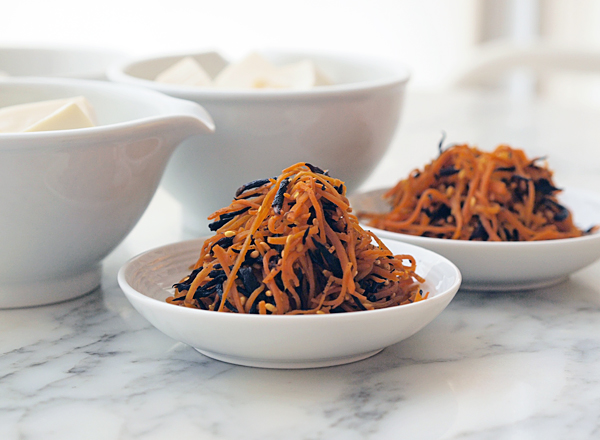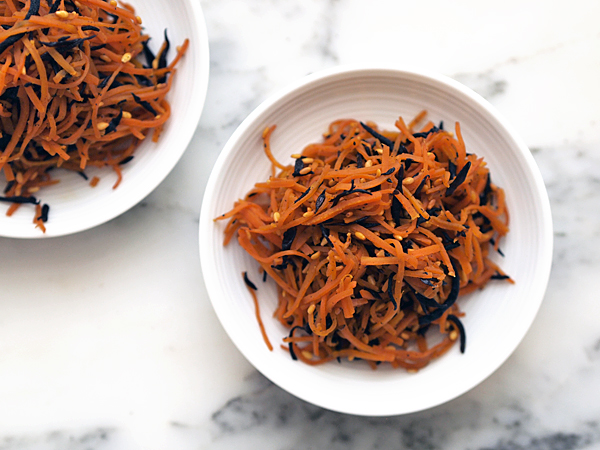
Pantry Basics: Kinpira Carrot (金平人参)
Kinpira carrot, stir-fried grated carrot seasoned with soy and sugar, was one of the dishes I learnt to cook at the Haru Cooking Class on our last trip to Kyoto. I know it probably isn’t high on your list of dishes to master, but it’s a delicious, quintessentially Japanese vegetable side dish which has opened my eyes to how home cooked Japanese meals are actually put together. And I simply love it. I never thought that I’d have the time, nor energy to create the assemblage of tasty little plates to go with a focal protein dish, which are so commonplace in family-style Japanese restaurants. But what I’ve come to realise is that many of these small bites—often designed to pair well with a bowlful of hot rice—can either be made in larger quantities and stored, or actually take very little time to prepare. Kinpira carrot is a classic example.
This incredibly easy to prepare sweet and savoury dish is served at room temperature. It’s a vegetable course that CH doesn’t complain about having to eat. In fact, he quite likes it. Kinpira carrot is lovely served with grilled teriyaki fish, hiyayakko (冷奴 or cold tofu) and some pickles (cucumber sunomono or 酢の物, a recipe I plan to share soon, is great and super quick to make). It’s equally great paired with a Japanese stew and a hot bowl of soup (although I often cheat and just make a cup of plum konbucha, 昆布茶, and call it soup). And it’s the perfect vegetable to go into a packed bento lunch with rice. I now make a double portion of it and store it in the fridge. Apart from serving it as part of a traditional Japanese meal, I love it in cold soba salads and it’s actually pretty awesome stuffed into a sandwich with cold cuts!
I’d tried a number of cookbook recipes for kinpira carrot in the past, but they always turned out a little too wet and soggy. I ended up having to keep it on the fire for too long, resulting in overcooked carrot. Taro’s instructions are clear and simple. And the finished dish is always al dente, with a satisfying swash of umami in it. You can also add burdock or substitute with sliced lotus root or julienned daikon. I’ve also read that parsnips work well.
Kinpira Carrot
Adapted from a recipe from Haru Cooking Class. You can also add a deseeded and slivered chilli if you like.
Serves 4 small portions
¼ tsp vegetable oil
100g carrots (you can use other root vegetables such as burdock root, lotus root, daikon), peeled and julienned or sliced
1 tsp castor sugar
1 tbs dark soy sauce (koikuchi)
1 tbs sesame seeds
1 tsp dried hijiki, soaked in water and drained
sesame oil
Heat the vegetable oil in a frying pan and stir fry the carrots until they just start to colour.
Add sugar and keep cooking on low heat until the moisture from the vegetables have evaporated.
Add soy sauce and continue to cook on low heat until there is no more liquid in the pan.
Remove from the heat, add sesame seeds, hijiki and a drizzle of sesame oil. Keeps refrigerated for up to one week.
About Su-Lyn Tan
Su-Lyn is Aun's better half and for many years, the secret Editor behind this blog known to readers simply as S. Su-Lyn is an obsessive cook and critical eater whose two favourite pastimes are spending time with her three kids and spending time in the kitchen. She looks forward to combining the two in the years to come.


awesome – I like to make an adult version by throwing in dried chilli flakes, and also letting it cook until some of the carrot sticks get a little brown/almost-crisp-fried at the ends! so good as a snack.
Hi Sonya, thanks for the tip!
I absolutely love this recipe. Thanks for sharing, Su-Lyn. Little C has been really fussy with her food lately, and I have a hunch this might help!
Dear Dawn, I hope she enjoys it! I’ve not thought to let T try some. Thanks for introducing that possibility to me 🙂